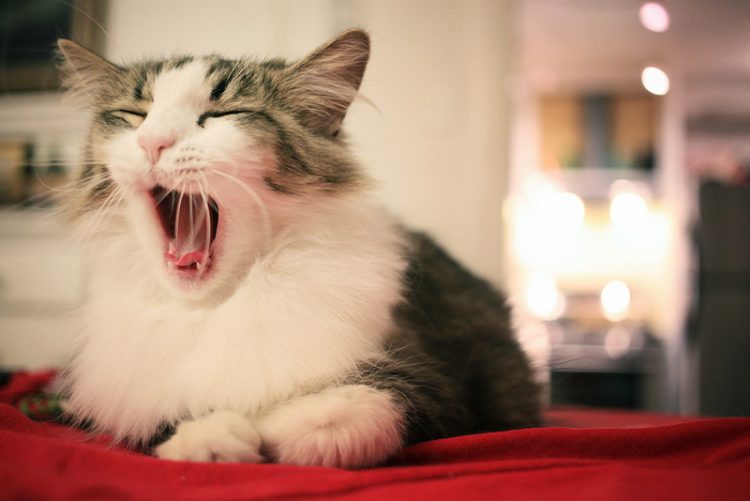
Moonlight, an Abyssinian, has started sleeping in the cricket chair in my bedroom at night. Cricket chairs are compact, comfortable chairs that sometimes turn up in furniture consignment shops. They have neatly turned legs and posts, padded (and usually skirted) seats and back cushions, and a quaint Beatrix Potter–style charm.
They are also regarded as prime real estate by cats. Mine are always trying to steal this particular chair from one another (the chair sleeps only one adult cat). Magwitch had it for an unusually long run. Then he hung out in one of the basement cat trees a little longer than usual one night, and Moonlight nabbed the chair.
But just a few weeks ago, she’d seemed perfectly content with her pile of quilts on the cellar shelf. Why the change?
Seasons Change
Change of season figures heavily in the never-ending quest for perfect sleeping spots.
“As the weather changes, you may notice your cat adjusts her sleeping accommodations accordingly,” notes writer Betty Lewis. “If home is a place that experiences noticeable temperature changes, your cat will likely seek a spot that’s not too hot and not too cold. That means you’ll likely find her stretched out in a sun spot or next to a heat source in cold weather months; in the heat of summer, look for her in darker, cooler places.”
Here, summertime marks the great migration downstairs to the cellar or, at the very least, to the breezeway. The floors in both rooms are tiled and cool. The downstairs shower stall and the marble-topped coffee table also become popular sleeping spots.
Kristen Wookey of Northeast Abyssinian & Somali Cat Rescue thinks weather definitely plays a factor, especially cold weather. “Cats that were otherwise not sleeping in the bed come back, seeking warmth,” she says.
A good case in point is Captain Jack, her foster cat. In the summer, he sleeps on top of the quilt. Come “fall and winter, he is crawling under the covers and sticking his head out like a human.”

Remembrance of Things Past
Much of what cats do is instinctual. A cat may have never put a paw outside, yet he will still do things that hark back to his untamed ancestors.
Most of Linda Schwarz’s cats stay indoors, but a few go outside during the day — with supervision. “I notice when they’re outside, they change the spot where they sleep,” the longtime cat lover remarks. She believes “it’s an instinct so that they’re not known to be in the same place” all the time.
One of her cats, Tony, is an indoors-only guy now, but he started off as a stray. Schwarz remembers, “He would always sleep in a different place.” Sometimes he’d nap in the neighbor’s doghouse. Other times, he’d sack out on a cat bed in her open garage. In warmer weather, she’d glimpse him sleeping on a mulch pile.
“In the wild,” observes Lewis, “a cat must be vigilant against predators; sleeping in unusual places is one way a cat can vary her routine to protect herself.” Animal behaviorist Susan Tripp spins this idea out a little further: “Cats see the world through the eyes of a predator and the eyes of prey.”
Your house cat’s ancestors knew or sensed how easy it was for the hunter to become the hunted. This wariness is hardwired into their descendants’ psyche. It’s the same instinct that sometimes drives a pampered mother cat to move her newborn kittens all around the house, even though they are perfectly safe.
It has also been suggested that cats in the wild rotated their sleeping places to keep fleas and other external parasites in check.
These cats have found some, uh, interesting positions in which to sleep:

The Territorial Imperative
Cats, like feudal lords, are great believers in hierarchy and territorial rights.
“In a multi-cat household, cats will alternate sleeping spots according to the hierarchy of the home, with the dominant cats claiming preferred sleeping spots and sharing them with more submissive family members, much as they do in the wild,” Lewis says.
There are bound to be shifts in the population. An old cat dies. A new cat or kitten joins the household. A long-term foster gets adopted. And with each shift, both the hierarchy and the territory shift, too.
Ask Moonlight. She took to the cellar when the kittens got on her nerves. When the last one left for his new home at the end of September, my lilac-colored friend came back upstairs and seized the power-sleeping chair.


